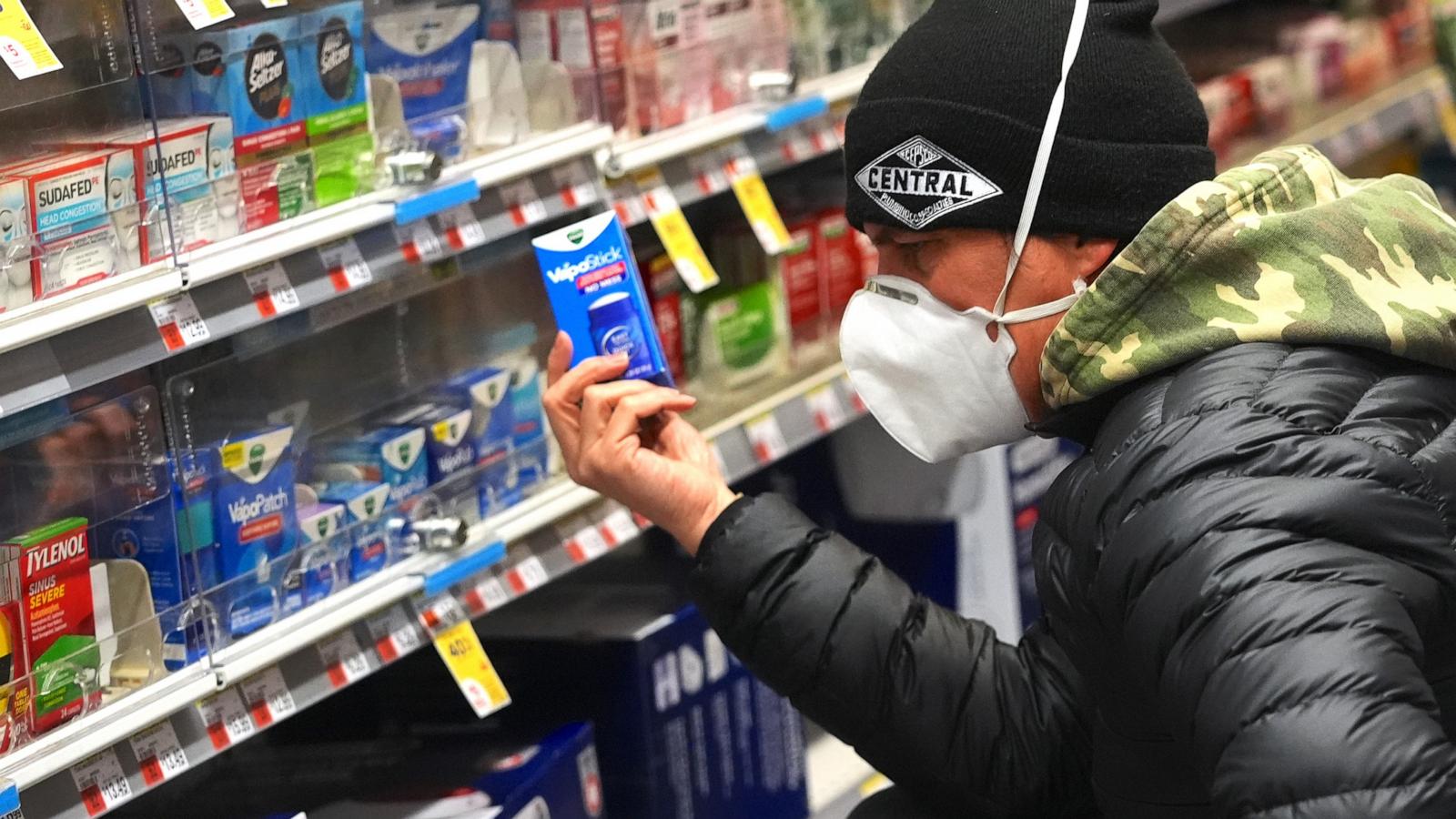Four viruses are currently circulating in the United States, which some have referred to as a “quad-demic.”
Data from the Centers for Disease Control and Prevention showed an increase in three respiratory viruses—COVID-19, flu and RSV—and the gastrointestinal disease norovirus.
Emergency department visits are “high” and “very high” for flu and RSV, respectively, and “elevated” for COVID-19 across the U.S., according to the CDC.
As of the week ending Jan. 4, 18.6% of tests for influenza are returning positive, as are 11.6% of RSV tests and 6.9% of COVID tests.
Meanwhile, for norovirus, 27.91% of weekly tests have come back positive during the same week, CDC data showed. This appears to be the highest levels seen since 2019.
Doctors told ABC News that although they feel ready to handle the influx of patients in their respective hospitals, the increase has been concerning.
“All of these viruses, including norovirus, classically go up in the winter months,” Dr. Scott Roberts, medical director of infection prevention at Yale New Haven Health, told ABC News. “Those numbers, at least for us locally, are pretty classic from what we’ve seen before, but the rate of increase has been especially concerning.”

Hospitals, emergency departments at capacity
Some doctors around the U.S. report hospitals are at or near capacity and patients often wait for hours before they are seen in emergency departments.
Dr. Matthew Sims, director of infectious disease research for Corewell Health, a health care system located in Michigan, said he’s seen several patients this week coming to the emergency room for influenza and COVID, and many of whom were admitted to the hospital.
“We are seeing patients who are having to wait before they can get transferred to a room,” he told ABC News. “I have a patient who’s in the ICU and was ready to come out and she just didn’t have a room, so it took a little while. So, the hospital itself is pretty full.”
Roberts said the main hospital has about 1,500 beds and about 150 patients, or 10%, are admitted with COVID, flu and RSV.
While this is below the number of patients admitted to the hospital with respiratory disease during the first COVID wave in 2020, Roberts said finding beds for patients can still be challenging.
“What we’re seeing now is that the hospitals near 100% capacity almost all the time, and when you add an extra 100 patients with respiratory viral disease who otherwise would not be there if this wasn’t respiratory viral season, you really tax the system,” he said. “And so, we are seeing that at Yale. We’re seeing a very full hospital near 100% capacity. We’re seeing very full emergency rooms with waits to get into the hospital because of that.”
Because of the long wait times and the full capacity, doctors are urging patients who may be sick with COVID, flu, RSV or norovirus to consider a virtual visit with a health care professional or to visit an urgent care center before considering going to a hospital.
An ‘atypical’ norovirus season
A rapid increase in norovirus cases occurring while respiratory virus season is peaking is “atypical” even though norovirus cases rise in winter, doctors told ABC News.
During the week ending Dec. 5, 2024, the latest date for which data is available, 91 norovirus outbreaks were reported.
“This year, the number of reported norovirus outbreaks have exceeded the numbers that we’ve seen recently and in the years before the pandemic,” a spokesperson for the CDC told ABC News in a statement.

A new norovirus strain becomes predominant every few years and exposure to one strain does not necessarily protect against all strains, the CDC said.
“Getting hit with norovirus at the same time that we’re hitting the peak of respiratory viruses — that’s the part that’s a little bit atypical,” Dr. Katie Passaretti, enterprise chief epidemiologist at Atrium Health, a health system based in Charlotte, North Carolina, told ABC News.
“With norovirus, it is a different strain than what we’ve seen in past years,” she continued. “So, some supposition that our usual baseline level of protection in the community might be a little bit lower, and that’s adding to the higher number of cases.”
Sims said he’s not sure why the number of norovirus cases is higher this season, but some of the increase in outbreaks may be attributed to increased testing availability for norovirus.
New masking, visitor guidelines
Hospitals are starting to restrict visitors and require masks in certain settings to prevent the spread of viruses.
Atrium Health said it asked its staff and visitors to wear masks in areas where direct patient care is being provided.
Novant Health, another health care system in North Carolina, began restricting visitors under the age of 13 on Tuesday.
“Children can also often carry viruses and not be as symptomatic as adults, and so we want to be careful about bringing those viral infections into our facilities,” Dr. David Priest, chief safety and quality officer at Novant Health, told ABC News.
Priest said Novant Health staff is also increasing the level of masking with recommendations that masks be worn in emergency departments and around vulnerable patients, including those with cancer or in skilled nursing units.
At Yale New Haven Health, the recommendation is that staff implement masking when taking direct care of patients.
“The fact that we’ve seen almost exponential increases at our hospital over the past few weeks, we are recommending that staff mask when seeing patients,” Roberts said. “There’s many metrics we monitor and information that goes into this decision, such as staff callouts, staff shortages, community respiratory viral test positivity rates, overall hospital census. These are just a few of the data points that go into that decision.”
Low vaccination coverage
There is no vaccine available to protect against norovirus, so the CDC recommends washing hands thoroughly with soap and water and staying away from others when sick.
However, flu and COVID-19 vaccines are available for both children and adults, and RSV vaccines are available for certain groups of adults. Despite vaccine availability, CDC data shows vaccination coverage remains low.
As of Jan. 4, only 43.4% of adults were vaccinated against the flu and 22.8% were vaccinated with the updated 2024-25 COVID-19 vaccine. Additionally, just 44.5% of adults ages 75 and older have received the RSV vaccine, according to CDC data.

Nearly half of all children are vaccinated against the flu at 42.9%, but just 11% have received the updated COVID-19 vaccine.
Doctors worry that the lack of vaccination will impact the health care system’s ability to treat patients because many adults are not protected against these viruses.
“I worry we are not as ready as we should be, or were, going into this season…because our vaccination rates for many of these diseases are very low for really the big three respiratory viruses, COVID, flu and now RSV, vaccination rates are well below what we would hope,” Roberts said.
“We really need to help with messaging the importance of these vaccines, because really the best method of prevention is vaccination, and it’s always easier to prevent an infection from occurring to begin with than to treat it once it’s already occurred, with antivirals, for example,” he added.
ABC News’ Youri Benadjaoud contributed to this report.
ABC News: Top Stories
Read the full article .


